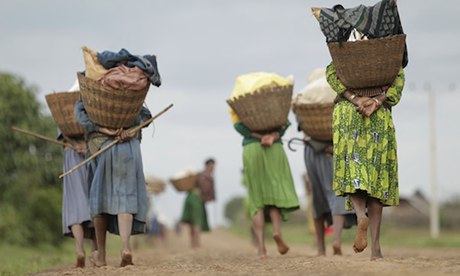Ethiopia now has a national plan for eliminating neglected tropical diseases, but success depends on disease mapping, monitoring, and making data accessible for policymakers

Elephantiasis can be caused by regular contact with volcanic red clay soil that irritates the skin. Photograph: Wellcome Trust
There are two principal causes of elephantiasis, or lymphoedema, in the tropics. The most common cause, and already known to be a significant public health problem, is lymphatic filariasis (LF). The other main cause is podoconiosis: a form of elephantiasis arising in barefoot subsistence farmers who are in long-term contact with irritant red clay soil of volcanic origins.
The disability associated with elephantiasis creates considerable stigma, and reduces productivity in patients. According to a study in Ethiopia, published by Tropical Medicine and International Health, the total direct costs of podoconiosis amounted to the equivalent of $143 (£88) per patient per year and a productivity loss of 45% of total working days per year.
Ethiopia recently launched its national master plan (2013-2015) for neglected tropical diseases, and podoconiosis and LF are two of the eight NTDs prioritised within it. In order to achieve the goals of this plan, health and development organisations will need a clear understanding of the geographical distribution and burden of the diseases. With that knowledge, they will be able to target priority areas and determine geographical overlaps among the disases to enable integrated control.
Elephantiasis is one of the NTDs with a clear potential for elimination. LF infection can be prevented and treated with a combination of medicines, while podoconiosis is easily preventable if shoes are consistently worn, and early stages can be successfully treated. For those who developed advanced disease of either cause there are proven ways to manage symptoms and prevent disabilities. Nonetheless control and elimination efforts can be hampered by a lack of information on the geographical distribution of the diseases.
One of the best ways to overcome this problem is by using integrated mapping. Mapping can help to identify populations at risk of diseases, indicate priority areas, target resources and help to monitor control progress.
A new initiative to map LF and podoconiosis in Ethiopia is underway, through a collaboration between several organisations. Supported by the Wellcome Trust, DfID and End Fund, the Ethiopian Health and Nutrition Research Institute (Ehnri) is working with Brighton and Sussex Medical School (BSMS), the Centre for Neglected Tropical Diseases, the Global Atlas of Helminth Infections at the London School of Hygiene & Tropical Medicine to map 1,384 communities in 692 districts, covering more than 130,000 individuals.
A total of 136 health providers have come together into 34 teams to survey the districts throughout the country. Each team includes a health officer, two nurses and a laboratory technician. The teams all receive training on data collection and diagnostic tools from experts from Ehnri and BSMS. Each of the 34 teams select two communities per district [with district health offices] based on reported cases of elephantiasis from health facilities.
About 100 individuals from each community are then randomly selected and included in the study. LF is diagnosed based on immunochromatography tests, while podoconiosis is diagnosed by excluding other causes of lymphoedema, supplemented by antifilarial antibody tests. The data is recorded using mobile phones collection to overcome the costs and challenges posed by paper-based surveys. For example, copying, transporting abnd storing forms can be expensive, and manual data entry often brings around errors.
For integrated LF and podoconiosis mapping, text messages are used to report number of cases of diseases under surveillance, and to help encourage patients to take medications. A big advantage of using smart phones is that they have built-in global positioning systems (GPS) to instantly capture geographic co-ordinates, which otherwise would have been collected using external handheld GPS devices. Results can be electronically entered at the point of data collection, transferred to a central database and analysed immediately after collection by researchers in Ethiopia.
The integrated mapping data collection has not been without its challenges. First, there is no rapid diagnostic test for podoconiosis. The diagnosis is established by excluding other causes of lymphoedema, and at times this is cumbersome for health providers. Second, althoughaccess to mobile phones is rapidly growing in Ethiopia, not all districts have network coverage, which can result in a backlog of data from the field.
However, the multi-organistion partnership has brought together national and global experiences in mapping and use of technologies. The collaboration with Ethiopian health ministry through Ehnri is expected to enhance uptake and country ownership of health data and maps more broadly.
The maps will be available for decision makers at national, regional and district level through publication and online databases. This will allow the Ethiopian health ministry and partners working on LF and podoconiosis to plan properly and better target their interventions to eliminate the disease.
You can find pictures showing the different stages of the integrated mapping process in this gallery.
Kebede Deribe is a research training fellow at the Wellcome Trust. Follow @KebedeDeribe on Twitter
This content is brought to you by Guardian Professional. To get more articles like this direct to your inbox, sign up free to become a member of the Global Development Professionals Network

No comments:
Post a Comment